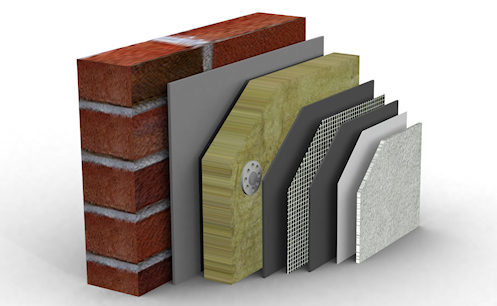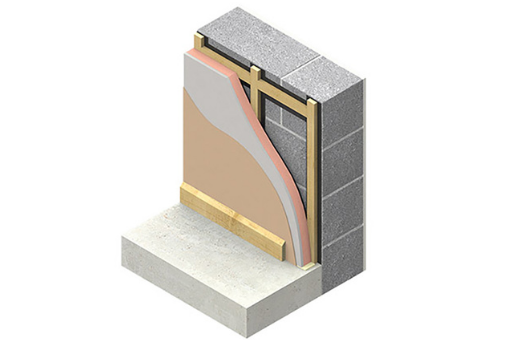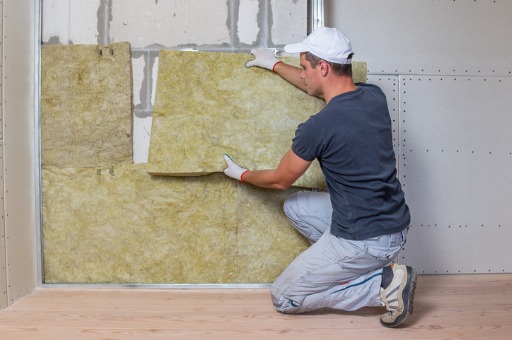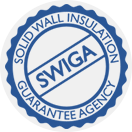SWIGA
Solid Wall Insulation Systems
The Different Solid Wall Insulation Systems
When it comes to the insulation of solid wall properties there are three main options:
- To put the insulation on the outside of the wall using an external wall insulation (EWI) system
- To insulate the inside of the walls with an internal wall insulation (IWI) solution
- By using a hybrid system which combines both EWI and IWI to provide the solution.
1: External Wall Insulation - EWI
External Wall Insulation (EWI) sometimes known as Solid Wall Insulation (SWI) involves fixing a layer of insulation material to the wall, then covering it with a reinforcement and a special type of render. The finish is usually a textured render, pebbledash or sometimes a brick slip or a brick effect render finish could be used.These finishes can be used alone, or in a combination, so that considerable variation in the appearance of the treated wall can be achieved.

Key Points – External Wall Insulation:
- Can save approx. £435* per property per year (Detached house – source: Energy Savings Trust)
- Can save approx.1.8 tonnes* of carbon dioxide per year (source: Energy Savings Trust)
- Can be applied with minimal disruption to the household and its occupants
- No internal access is required
- Does not reduce the floor area (living space) of the property
- Improves the appearance of the property – potentially increasing the property’s value
- Improves weatherproofing and sound resistance
- Will make the building more airtight, reducing heat loss (Need to ensure the building has sufficient natural and mechanical ventilation)
- Reduces the risk of condensation
2: Internal Wall Insulation - IWI
Where it is not practical to install external wall insulation for example if a stone or ornate facade is wished to be maintained then Internal Wall Insulation (IWI) can be incorporated instead. IWI is applied to the internal walls of a building. It typically consists of dry lining in the form of pre-insulated plasterboard or built-up systems using insulation such as mineral wool or foam panels held in place using a studwork frame.

Key Points - Internal Wall Insulation:
- Is generally cheaper to install than external wall insulation
- will reduce the floor area of any rooms in which it is applied (the thickness of the insulation can be up to around 150 mm)
- Can be disruptive as works are internal
- Requires skirting boards, door frames, radiators and external fittings to be removed and reattached
- Intermediate floor voids need to be insulated to stop damaging cold spots
- Can make it hard to fix items to inside walls without puncturing the membrane – although special fixings are available
- Needs any problems with cracking, penetrating or rising damp or poor mortar joints to be fixed first
- Should not insulate one side of a pair of semidetached houses
3: Hybrid Insulation System
This will cost more than insulating a standard cavity wall, but the savings on heating bills can be larger too, because more insulation can be used on the inner or outer walls.Internal Wall Insulation (IWI) is applied to the internal walls of a building. It typically consists of dry lining in the form of pre-insulated plasterboard or built-up systems using insulation such as mineral wool or foam sheets held in place using a studwork frame.
External Wall Insulation (EWI) involves fixing a layer of insulation material to the wall, then covering it with a reinforcement and a special type of render. The finish is usually a textured render, pebbledash or sometimes a brick slip or a brick effect render finish could be used.
These solutions can also be used in conjunction with each other, known as a Hybrid solution, where EWI is used on the front of the property and IWI at the rear. This is common if there are restrictions (i.e. listed building, conservation areas, etc) that meant an IWI or EWI systems on their own would not be suitable.

Join SWIGA And Access The Knowledge Hub For FREE
If you're a housing professional or involved in the specification of solid wall or external wall insulation systems then joining SWIGA as an Associate Member will give you access to the SWIGA Knowledge Hub and a wealth of information to help you at every stage of your project.
Joining as an Associate is absolutely FREE - all we ask is that you are either a member of a professional body related to the construction industry, work for a company or organization that operates in the housing refurbishment or energy efficiency sector or have a professional qualification related to the construction industry.
Joining as an Associate is absolutely FREE - all we ask is that you are either a member of a professional body related to the construction industry, work for a company or organization that operates in the housing refurbishment or energy efficiency sector or have a professional qualification related to the construction industry.
